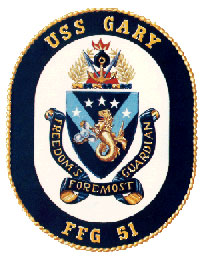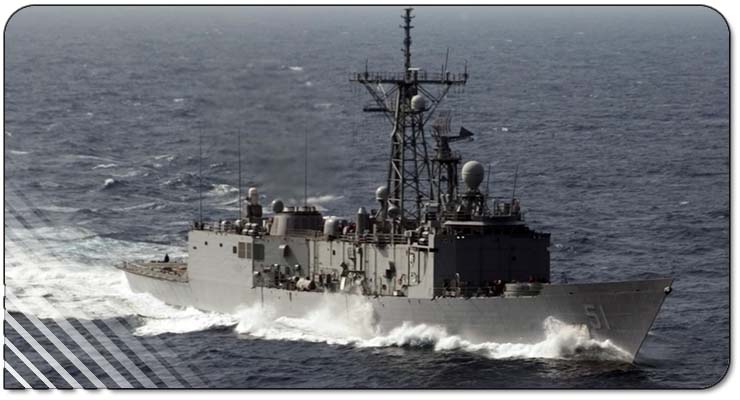Namesake:
Commander Donald Arthur Gary
Donald Arthur Gary was born on 23 July 1903 in Findlay, Ohio. He
enlisted in the U. S. Navy on 12 December 1919 and served as an
enlisted sailor until November 1943, when he was commissioned a
Lieutenant (junior grade). He progressed to the rank of Lieutenant
Commander in March 1946 and, when he retired on 1 June 1950, he was
advanced to the rank of Commander on the basis of combat awards.
Commander Gary died on 9 April 1977. His onshore duties during his
naval career included assignments in the Third Naval District, New York
City; the Office of Assistant Inspector of Machinery, B&W
Company,
Ohio; the staff of Commander Submarine Group ONE, New York; and the
Naval Disciplinary Barracks, Terminal Island, California. His sea duty
tours included ELCANO (PG 38), HANNIBAL (AG 1), SWAN (AM 34), IDAHO (BB
42), INDIANAPOLIS (CA 35) for two tours, ENTERPRISE (CV 6), and
FRANKLIN (CV 13), that (then) Lieutenant Gary joined as an Engineering
Officer in December 1944.
On 19 March 1945, FRANKLIN was operating with a fast carrier task force
against remnants of the Japanese fleet when it was severely damaged by
fires caused by two Japanese bombs in an attack. Only outstanding
efforts on the part of the crew, and Lieutenant Gary in particular,
saved the ship from destruction and the lives of many sailors.
Lieutenant Gary was awarded the Medal of Honor, with a citation that
stated:
"For conspicuous gallantry and intrepidity at the risk of his own life
above and beyond the call of duty as the Engineering Officer attached
to the USS FRANKLIN when that vessel was fiercely attacked by enemy
aircraft during operations against the Japanese home islands near Kobe,
Japan, March 19, 1945. Stationed on the third deck when the ship was
rocked by a series of violent explosions set off in her own ready
bombs, rockets and ammunition by the hostile attack, Lieutenant Gary
unhesitatingly risked his life to assist several hundred men trapped in
a messing compartment filled with smoke and with no apparent egress. As
the imperiled men below decks beacon increasingly panic-stricken under
the raging fury of incessant explosions, he confidently assured them he
would find a means of effecting their release and, groping through the
dark, debris-filled corridors, ultimately discovered an escape.
Staunchly, he struggled back to the messing compartment three times
despite menacing flames, flooding water and the ominous threat of
sudden additional explosions, on each occasion calmly leading his men
through the blanketing pall of smoke until the last one had been saved.
Selfless in his concern for his ship and his fellows, he constantly
rallied others about him, repeatedly organized and led fire-fighting
parties into the blazing inferno on the flight deck and, when fire
rooms 1 and 2 were found to be inoperable, entered the number 3 fire
room and directed the raising of steam in one boiler in the face of
extreme difficulty and hazard. An inspiring and courageous leader, (he)
rendered self-sacrificing service the most perilous conditions and, by
his heroic initiative, fortitude and valor, was responsible for saving
of several hundred lives ...."
The damaged FRANKLIN returned to New York harbor, and Commander Gary
remained aboard the ship until it was decommissioned in 1947. On 23
January 1946 he was presented the Medal of Honor at the White House by
President Harry S. Truman.
|
Ship's Crest:
 The Shield:
The light blue "V" shape signifies
the Medal of Honor ribbon as it rests on the dark blue of the Navy
uniform. The "V for Victory" symbol was also used extensively during
World War II at the time Commander Gary, then a Lieutenant, was awarded
the Medal of Honor. The five white stars are from the medal service
ribbon. The sea lion, long a symbol of courage at sea, represents the
courage shown by Lieutenant Gary when he saved hundreds of his
shipmates from violent death at sea. The ship's propeller denotes that
he was an engineering officer that directed, at great personal risk,
the raising of steam to get his damaged and imperiled ship underway
after an enemy attack. The Shield:
The light blue "V" shape signifies
the Medal of Honor ribbon as it rests on the dark blue of the Navy
uniform. The "V for Victory" symbol was also used extensively during
World War II at the time Commander Gary, then a Lieutenant, was awarded
the Medal of Honor. The five white stars are from the medal service
ribbon. The sea lion, long a symbol of courage at sea, represents the
courage shown by Lieutenant Gary when he saved hundreds of his
shipmates from violent death at sea. The ship's propeller denotes that
he was an engineering officer that directed, at great personal risk,
the raising of steam to get his damaged and imperiled ship underway
after an enemy attack.
The Crest: The anchor, without
stock, is one of
the distinguishing features of the Navy's Medal of Honor, and is also
an ancient symbol of the sea. The fire bomb with three flames signifies
the three times Lieutenant Gary went back through fire and exploding
bombs to lead several hundred men to safety. The arrowheads are
representative of the destructive force of the guided missiles of USS
GARY (FFG 51). The setting sun is symbolic of the heroic actions of
Lieutenant Gary that took place off the coast of Japan near the end of
the war. The palm fronds denote his honor and service in the South
Pacific area.
Motto: On an azure scroll in doubled
gold is the motto "FREEDOM'S FOREMOST GUARDIAN"
|

